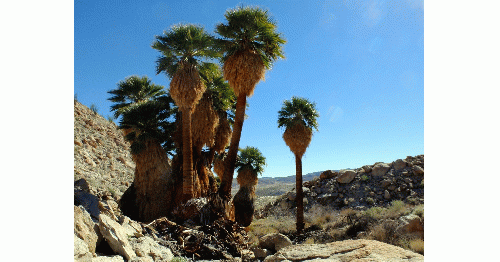
California Fan Palms in Anza-Borrego State Park in California (Photo by author)
(Image by Kollibri terre Sonnenblume) Details DMCA
The term "native plant" has become a common one, and many people probably assume that the definition is clear cut. However, like many other seemingly simple designations, that's not the case.
Whether a given plant is considered "native" where it is found growing is dependent on the interpretation of the interrelation of three factors: time, place and human involvement.
So, in the United States, a plant is generally considered native only if it grew here before European colonization. On the East Coast, that's the 1500s and in California, that's 1769. Plants introduced since then, whether deliberately or by accident, are labeled "non-native," "introduced," "exotic," or in some cases, "invasive."
In the UK, some would set the date for ~8000 years ago, when rising sea levels made those landmasses islands.
The checkered history of "nativeness"The UK was where the concept of "nativeness" was first proposed, in the mid-19th century, by Hewett Coltrell Wallace. Coltrell also included "naturalized" species, which were species that humans had introduced but which had come to live without them unaided.
The correlation of native=good and non-native=bad was first popularized by the Nazis. In reference to an introduced Asian plant species, Impatiens parviflora, a team of biologists there wrote: "As with the fight against Bolshevism, in which our entire Occidental culture is at stake, so with the fight against this Mongolian invader, in which the beauty of our home forest is at stake."
A US American took up the cause next. In 1958, a man named Charles Elton published a book entitled, "The Ecology of Invasions by Animals and Plants" which was not so much a scientific treatise as a polemic laden with war jargon. He set a bellicose tone against "invasives" that is still with us today.
In the late 1990's, the National Invasive Species Council was promulgated by an executive order of Bill Clinton, with Monsanto and other chemical giants among the parties who helped design it (in order to encourage the use of the herbicides they manufacture). State and local governments took their lead from this council, quickly spreading its viewpoints and methodologies nationwide.
Plants on the moveReturning to the world of empirical science, we know that, historically, plant ranges have always been in flux, often in response to climatic shifts. Fossils and phylogenetics are two things that can show us where plants used to live and where they came from. Such information, though, raises questions even as it illuminates.
For example, when Spanish colonists arrived in California in the 18th Century, Coast Redwoods (Sequoia sempervirens) grew in a strip nearly 500 miles long and 5-47 miles wide from what is now Monterrey County in the south to Curry County (Oregon) in the north. But only 10,000 years ago, they grew as far south as Los Angeles, and five million years ago, they were found in Europe and Asia. Today (after over 95% of the Coast Redwoods in California were heartlessly cut) the species has been spread around the world by humans, including to New Zealand, where a 15 acre grove has been growing for over a century. Due to favorable differences in soil and rainfall there, the trees happen to grow faster than on the US West Coast.
The grievous sin of destroying so many Redwoods in California is compounded by the fact that much of their former habitat is now so altered by factors such as erosion from logging and that it won't be home to these grand trees for the foreseeable future.
We can ask, then, whether such degraded places still comprise part of the current "native range" of the species. Further, we could also ask why that range cannot include places like the grove in New Zealand where the tree is thriving? Or whether a Redwood grown in a European location within its historic range 5,000,000 years ago is truly "exotic" or if it's just coming home?
For many, the issue is "human interference" as opposed to "natural dispersal."
In this way of thinking, the Creosote Bush (Larrea tridentata), an emblematic plant of the US Southwest's Mojave Desert is native even though it's from South America, because its means of conveyance over those many thousands of miles was non-human; possibly in the tail feathers of migrating plovers.
(Note: You can view every article as one long page if you sign up as an Advocate Member, or higher).





